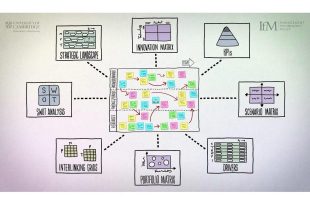Roadmapping is a framework and approach that integrates a number of perspectives relevant to a policy or project – including ‘what needs to be done’, ‘why is it needed’ (‘pull’) and ‘how it is to be achieved’ (‘push’), all mapped against time (‘when’) – often in a visual, easy to communicate format. It is identified in the Government Office for Science’s Futures Toolkit as one of the ‘most flexible and emergent tools’ for ‘developing and testing policy and strategy’. While it is perfectly suited to this role, roadmapping can play a more central role in strategy, innovation and future-focused toolkits.
All management methods (or tools) have strengths and weaknesses, typically associated with what is explicitly included in the core representation and what is not, respectively. Skilled practitioners will consider implicit factors when using such tools, with naïve use focusing on the explicit only. For example, where is the time dimension in the well-known ‘SWOT’ (Strengths-Weaknesses-Opportunities-Threats) method? Time is an important dimension in strategy and foresight, and a SWOT analysis should be more than a simple list of key strengths, weaknesses, opportunities and threats in a 2x2 table.

www.youtube.com/watch?v=0JxsSHjyJPc
Roadmapping has two key strengths as a Futures method
- The rich visual nature of roadmaps provides effective support for communication of strategy. The structure of roadmaps enables cross-stakeholder dialogue during the process of roadmapping, providing a common big-picture view and language, building consensus around actions to move forward.
- - The uniquely holistic time-based systems architecture of roadmaps is very powerful for alignment, integration and synchronisation of strategic information, processes and tools. Including the time dimension explicitly allows change, transformation, convergence, disruption and other dynamics in innovation systems to be considered. Roadmaps can support coordination of the various elements in an innovation system and programme management.
However, roadmapping also has some weaknesses. In particular, the method is not analytically strong, and must generally be combined with other more specialised tools to develop well-founded and effective strategic plans. For example, the scenario planning method is often used to better understand what the potential future might look like.
However, when used alone scenarios can be unconnected to the present, with pathways to the future scenarios and their impact on current actions often unclear. Combining roadmaps and scenarios makes for a much stronger toolkit, with other management tools incorporated depending on context.
So when is it best to use Roadmapping?
Roadmapping can be used to develop and test policies and strategies. However, it can also be used as an integrating ‘knowledge hub’, helping combine other strategy and Futures tools, without competing or conflicting with them. The time-based systems architecture provided by roadmaps helps to define focus and scope, enabling data alignment and scalability of the toolkit.
Further information:
- Watch the ‘what is roadmapping’ animation
- Find out more about roadmapping on the Institute for Manufacturing website
- Visit Rob Phaal’s website for a personal view on roadmapping
- View the Government Office for Science’s Futures Toolkit
Dr Robert Phaal
Director of Research (STIM)
Department of Engineering
University of Cambridge
Rob Phaal works within the Department of Engineering at the University of Cambridge, where he researches the application of engineering principles and methods to management and organisational challenges in the context of high-tech innovation and strategy.